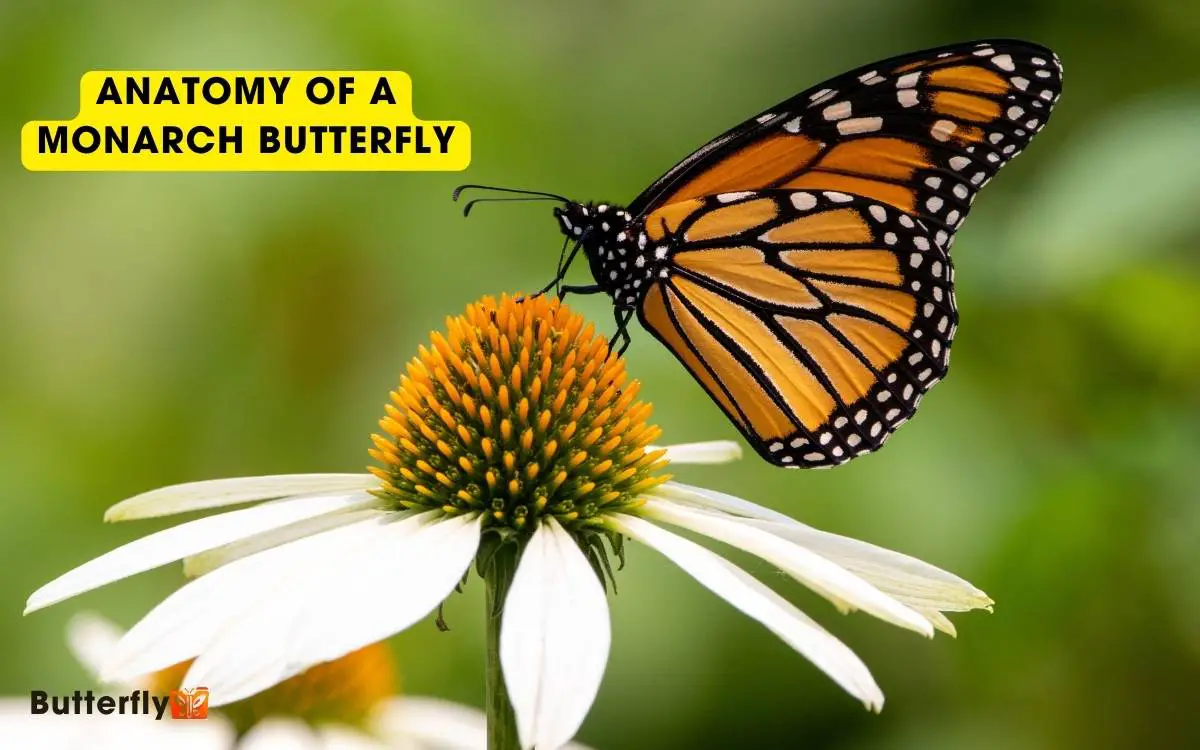Anatomy of a Monarch Butterfly: Detailed Overview!
You’ll find the anatomy of a Monarch butterfly truly fascinating. Its wings, comprising two forewings and two hindwings, are covered in tiny scales that reflect light and are supported by veins for aerodynamic stability.
Antennae, equipped with chemoreceptors and mechanoreceptors, aid in orientation and food detection. Six legs ending in tiny claws are equipped with sensory receptors for orienting and identifying host plants. There’s a lot more to discover in their intricate design.

Key Takeaways
Wings
The wings of a monarch butterfly, characterized by their striking orange and black pattern, play an essential role in both flight and thermoregulation.
You’ll observe that these wings are composed of two forewings and two hindwings, each covered in tiny scales that reflect light, creating vivid coloration. The veins within the wings provide structural support, ensuring aerodynamic stability.
When the butterfly warms itself, it angles its wings towards the sun, allowing maximum surface area for heat absorption. You’ll notice the wings’ flexible yet sturdy nature enables agile and sustained flight, vital for their long migratory journeys.
This detailed structure not only facilitates locomotion but also aids in regulating the butterfly’s body temperature, essential for survival in varying climates.
Proboscis
A monarch butterfly’s proboscis functions as a specialized feeding tube, coiled under its head when not in use.
You’ll observe that this elongated, flexible structure unfurls to access nectar deep within flowers.
Comprising two interlocking halves, the proboscis uses capillary action to draw liquid nutrients into the digestive system.
It’s fascinating how the butterfly can precisely control this organ, extending and retracting it with ease.
When the proboscis is extended, specialized muscles and nerves coordinate its movement, ensuring efficient feeding.
The proboscis’ design is an evolutionary adaptation, enabling the monarch to feed on a variety of floral species.
Eyes
While the proboscis is integral for feeding, monarch butterflies rely on their compound eyes to find their way and locate nectar sources. Each eye consists of thousands of ommatidia, tiny individual lenses that provide a broad field of view.
This complex structure allows monarchs to detect ultraviolet light, essential for identifying flowers and orienting during migration.
You’ll notice that their vision is adapted to their specific ecological needs. They can perceive polarized light, aiding in orientation with the sun’s position. These eyes are adept at detecting movement, important for avoiding predators.
Unlike human eyes, monarch compound eyes don’t produce a single, focused image but rather a mosaic of multiple images, giving them a unique yet highly effective vision system for their survival and reproduction.
Antennae
Monarch butterfly antennae serve as vital sensory organs, enabling them to detect chemical cues and navigate their environment with precision.
These long, slender appendages are covered with chemoreceptors that allow the butterfly to identify food sources and potential mates.
The antennae are also equipped with mechanoreceptors, which help the butterfly sense changes in air currents, aiding in flight stability.
Here’s how the antennae function:
- Chemoreception: Detects pheromones and plant volatiles.
- Mechanoreception: Senses air movement for flight coordination.
- Orientation: Assists in spatial navigation and migratory routes.
- Circadian Rhythms: Helps regulate day-night cycles through light sensitivity.
Your understanding of these sensory roles highlights how monarchs interact with their ecosystem and adapt to environmental changes.
Legs and Feet
The legs and feet of a monarch butterfly are equipped with specialized sensory organs and structures that facilitate feeding, locomotion, and environmental interaction.
Monarchs possess six legs, each featuring tarsal segments ending in tiny claws. These claws help grip surfaces, aiding in stability and movement.
You’ll find chemoreceptors on the feet, which allow the butterfly to taste and identify host plants. When a monarch lands, it uses these receptors to detect nectar and suitable egg-laying sites.
Additionally, the legs contain mechanoreceptors that sense vibrations and pressure changes, providing vital feedback about the surrounding environment.
This combination of sensory inputs and structural adaptations ensures monarch butterflies navigate their habitats efficiently while performing essential life functions.
Conclusion
Imagine holding a tiny, intricate puzzle. Each piece, from the wings to the antennae, fits together perfectly, creating the marvel that’s a monarch butterfly.
When you observe its wings, you’re looking at a masterpiece of evolution, designed for migration over thousands of miles. Just as each part of the butterfly is essential, your understanding of its anatomy completes the picture.
It’s a reminder of how interconnected life’s details are, much like the delicate balance in nature itself.






